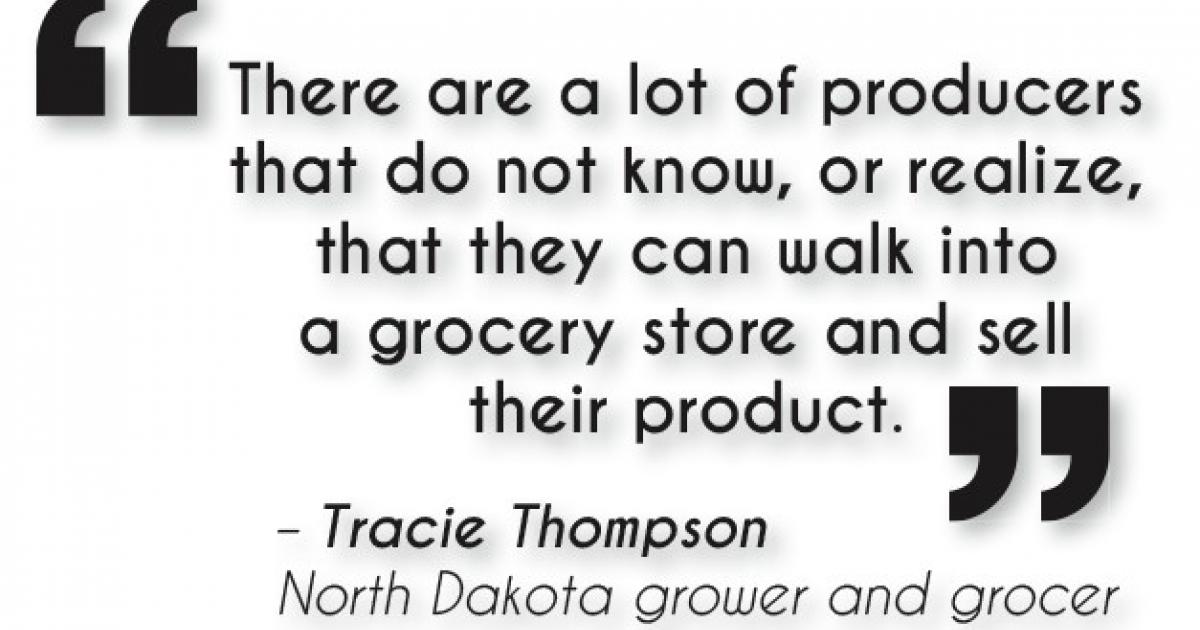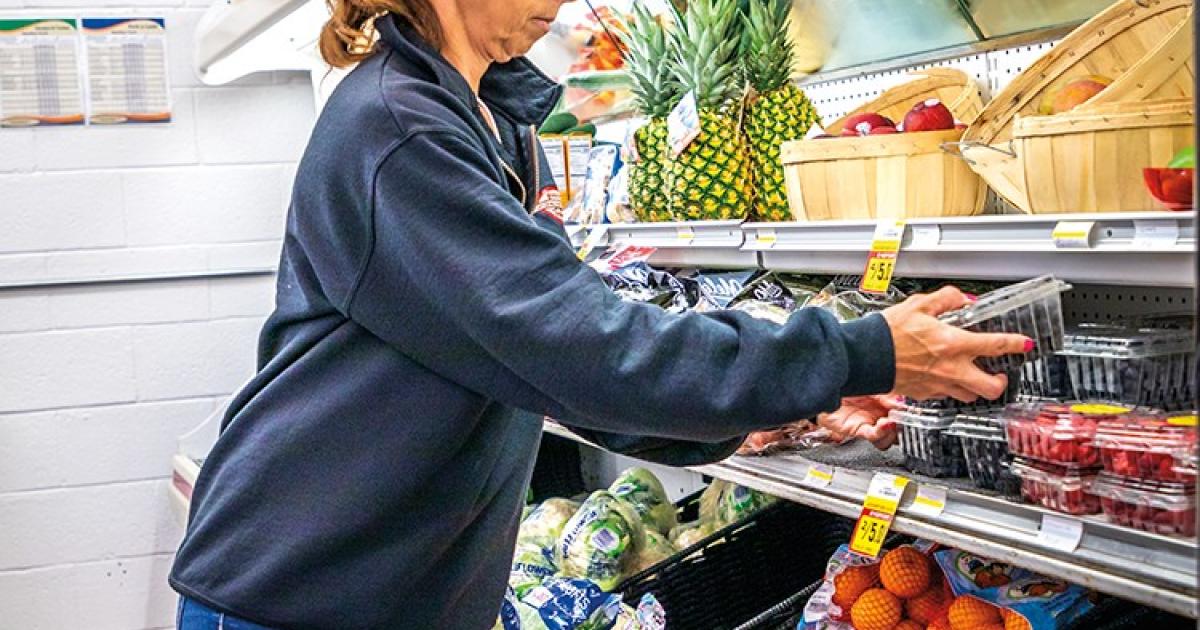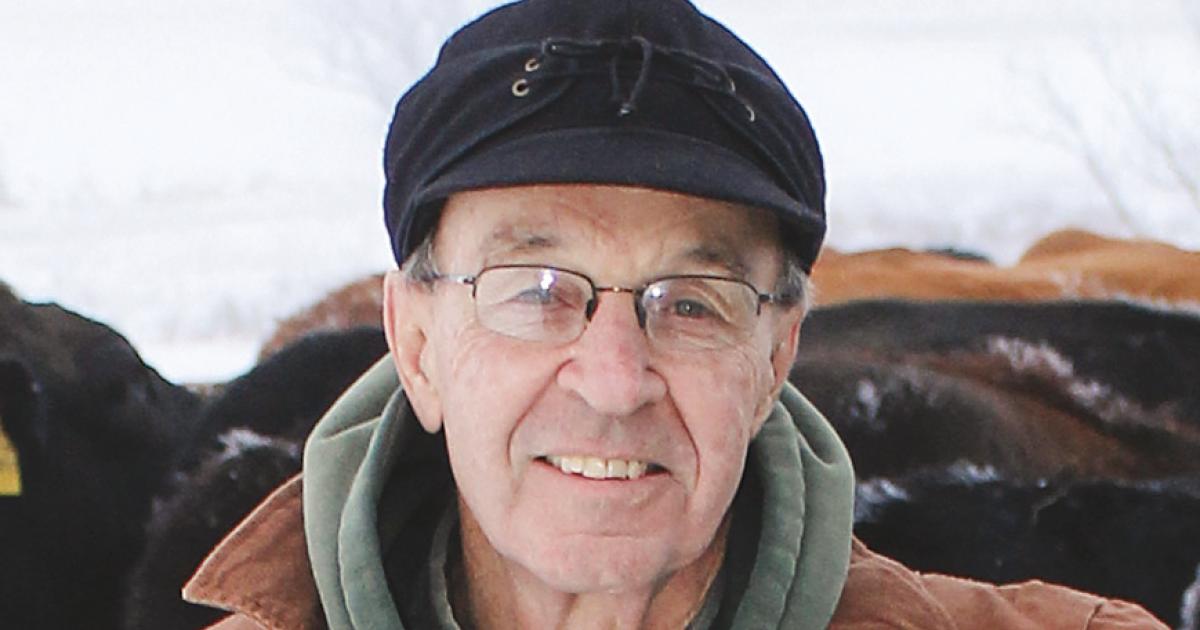The streets were quiet when John Mundt parked his side-by-side in front of Jason’s Super Foods in the small town of Westhope, on the hunt for coffee filters.
“Why don’t you sell those gingersnaps?” the overalls-clad Mundt asked grocery store manager Tracie Thompson, as she led him to the filters.
Their banter was friendly, perhaps familiar to other rural grocery store owners or managers, who serve a customer base reflective of the local population. Thompson assures Mundt she’ll look into adding gingersnap cookies to the shelves. But it’s never that simple.
Jason's Super Foods Manager Tracie Thompson helps customer John Mundt in his search for coffee filters in small-town Westhope. Photos by NDAREC/Liza Kessel
Many factors outside of Thompson’s control will determine if she can oblige Mundt’s request. Price. Supply. Distribution. Allocation. Add the increased price tag to obtain lower volumes of goods and higher transportation costs to rural areas, and the shelf price of gingersnaps might be more than Mundt or other customers are willing to pay. The options dim. Sell the cookies at a loss or don’t get the gingersnaps at all?
This conundrum speaks to a much larger issue – one that has been given a platform by a worldwide pandemic.
“The pandemic illustrated how our food supply chain is broken,” says Lori Capouch, who spearheads the North Dakota Rural Grocers Initiative as rural development director for the North Dakota Association of Rural Electric Cooperatives (NDAREC). “We worked for six years to try to prove that we needed food in rural areas. Sales have gone up by 100 percent, and we’re finally admitting that our supply chain is broken, that we need food in rural areas.”
The coronavirus pandemic disrupted the supply chain, cutting off global distribution channels and shutting meat packing plants. Grocers couldn’t keep up with demand.
“When it first hit, people were panic-buying things that they didn’t need to,” Thompson says. “Things got really expensive and were going up in price for (grocers) to get. Once packers shut down, it was hard to get ground beef. We were paying $3.69 a pound (pre-pandemic) to get ground beef, and it was going up to $7.29 a pound.”
Some fresh produce was also hard to get, depending on where it was sourced. At one point, the retail price of a clamshell of baby spinach at her store would have been $11.01. Thompson struggled to reconcile charging such high retail prices to get products in the store, because she knew it meant creating food waste – her customers unable to afford the price.
“When you live in a town this size, people couldn’t afford it,” she says.
And Thompson knows her community. Prior to taking over as general manager of the Westhope store in May 2019, she was known as “the tomato lady.” Thompson and her family are local growers, who sell their produce at farmers markets and area groceries and welcome visitors to their Bottineau County farm in rural Antler.
Being both a producer and a grocer, Thompson has an intimate knowledge and understanding of the food supply chain. Like Capouch, she sees brokenness. But she also sees an opportunity to educate others – producers and consumers alike – about the tools and resources currently available to strengthen the local food supply, and in turn, boost rural economies. Her voice is part of a larger effort in North Dakota to build grower-grocer relationships and strengthen the farm-to-market connection in local communities. Aptly put, it’s a homegrown revolution.
HOMEGROWN REVOLUTION
After deciding she needed to learn how to garden, Thompson read books, did research and enlisted the help of her late father-in-law. She remembers her first planting season well.
“I planted everything, and I didn’t mark it,” she says. “I didn’t know if it was a weed or a plant!”
As her gardening skills grew, so did the size of her garden – up to 800 tomato plants and 1,500 pepper plants. Ten years ago, a high tunnel was installed at the Thompson farm and a few years later, she started selling her produce at farmers markets. Through this venture, she met Holly Mawby, director of the Entrepreneurial Center for Horticulture at Dakota College at Bottineau and executive director of the North Dakota Farmers Market and Growers Association. With Mawby’s help, Thompson got connected to a Minot grocery store, where she started direct selling her produce. Today, her produce is sold at Jason’s Super Foods stores in Westhope and Mohall.
While her high tunnel is certified through the First District Health Unit in Minot, Thompson says local growers can sell their produce directly to grocery stores without being certified.
“There are a lot of producers that do not know, or realize, that they can walk into a grocery store and sell their product,” she says.
According to North Dakota’s Guide to Direct Farm Marketing produced by the N.D. Department of Agriculture, the N.D. Department of Health considers farmers approved sources of fresh raw fruits and vegetables that they grow themselves. There are some regulations, however, and the guide encourages farmers to check with their local health units for additional standards. At Jason’s Super Foods, Thompson is allowed to buy locally sourced produce that is whole, uncut and unprocessed.
By sourcing fresh produce from local farmers, everyone benefits, Thompson says. Grocers eliminate some of the transportation and related costs to obtain fresh produce from distributors, farmers have a market to sell their produce at a price they choose, and customers receive the benefit of the freshest produce at an affordable retail price.
“Customers want fresh if they can get it, and we don’t have a cap on what we can and can’t buy (at the grocery store),” Thompson says.
The N.D. Department of Agriculture has a variety of resources and tips to help farmers interested in direct marketing their produce. Simply adding stickers to produce, identifying which farm it came from, is a good practice. And get to know your local grocer, Thompson says.
“We have a lot of people in North Dakota who grow great local foods, and they end up giving it away because they don’t know what to do with it,” she says. “If you are a producer, please reach out to your local grocery or even a local convenience store.”
RURAL’S FOOD FUTURE
While grocery store sales have drastically improved in rural areas during the pandemic, the future of rural groceries is connected to the strength of the supply chain.
“For the grocery store, I think we’ll be OK. It will be about supply,” Thompson says. “If you can keep your supply to meet your demand, you’ll be fine. But if they keep having regulations on (supply), it’s going to put a strain on it.”
But if North Dakota is successful at building more grower-grocer relationships and strengthening the consumer’s connection to local farms and foods, the COVID-19 pandemic may, ultimately, improve the market for the local producer.
“I think they’re going to see a lot higher demand and do better for themselves,” Thompson says. “The possibilities are limitless.”
Visit www.ndsmallfarms.com(link is external) to learn more.
Cally Peterson is editor of North Dakota Living. She can be reached at cpeterson@ndarec.com.
PRODUCER TIPS FOR SUCCESSFUL MARKETING
• Network. Your best source of information may be talking with people who have been there.
• Consistent, quality products attract repeat customers.
• Set your prices and stick to them.
• Work with fellow vendors to set fair prices for products. Everyone needs to work together to establish quality market standards.
• Maintain and update your customer list. Use it to email reminders, market openings, special events and new product information. This builds lasting relationships.
• Watch market trends. Read about food trends and be flexible and willing to try new things.
• Consider adding value to your products with gift cards, specialty items, newsletters, recipes, special requests, etc.
• Creative packaging, signs and displays can make your business stand out in a crowd.
• Be organized. Set up early and be prepared to make that first sale of the day.
• Tell your story with photos of your day-to-day operation. A picture is worth a thousand words.
• Advertise, advertise, advertise. Never assume customers know you are there. Take advantage of free public service announcements, send press releases and place signs whenever and wherever you can.
• Know your product. You’re its best advertising!
SOURCE: N.D. Department of Agriculture, Farm to Market: North Dakota’s Guide to Direct Farm Marketing













